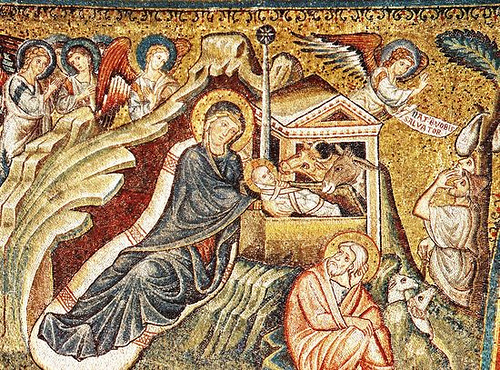We run our website the way we wished the whole internet worked: we provide high quality original content with no ads. We are funded solely by your direct support. Please consider supporting this project.

The Cross in the Manger
There has been a strand within the Western theological tradition—one that is especially prevalent in contemporary American Evangelicalism—that construes the significance of the cross in strictly soteriological terms. The cross is central, in this view, but only in the sense that the reason Jesus came to earth was to pay the price for our sin by dying, thereby allowing God the Father to vent his wrath on him in our place. This myopic focus, combined with this “penal substitutionary” understanding of the atonement, tends to relegate everything else Jesus said and did leading up to his passion to a secondary status. Hence, far from providing the thematic center of Jesus’ identity and mission, this perspective tends to divorce the cross from every other aspect of Jesus’ identity and mission.
The union of God and man in Jesus is “one dynamic event from the incarnation to ascension,” as T. F. Torrance wrote. God did not unite himself to a man and then, as a secondary thing, act. Instead, in Jesus, his personhood, his words and his acts are inseparable.
If this is true, then we can never separate who Jesus is as the God-man from what he did. We can also no more separate Jesus’ atoning work on the cross from the Incarnation and/or any other aspect of his life and ministry. Torrance writes, “we must think of [Christ’s] incarnate life and his redeeming activity as completely interwoven from his conception and birth to his crucifixion and resurrection.” And again, “Incarnation and atonement intrinsically locked into one another constitute the one continuous movement of God’s saving love for the world.”
Moltmann makes a similar point, when he asserts:
The incarnation of the Logos is completed on the cross. Jesus is born to face his passion. His mission is fulfilled once he has been abandoned on the cross. So it is impossible to speak of an incarnation of God without keeping this conclusion in view. There can be no theology of the incarnation which does not become a theology of the cross. As soon as you say “incarnation,” you say “cross.”
We cannot separate his death out from his life. The cross is the quintessential expression of who Jesus was and everything he was about. The indivisible and perfectly integrated wholeness of the one in whom God became human is oriented, from manger to ascension, around the cross. We could say the same thing by claiming that Jesus’ mission centered on sacrificially reconciling humanity to God, or by claiming that Jesus’ mission centered on revealing God’s true, self-sacrificial, loving nature to humanity. The atonement and revelation are two sides of the same coin. God reconciles humanity to himself by revealing his true loving character, and God reveals his true loving character by reconciling humanity to himself. And this revelation-that-is-reconciliation and reconciliation-that-is-revelation takes place in the Word made flesh, understood as “one dynamic event from incarnation to ascension”.
If it is the whole unity of the person and work of Jesus that reveals God to us, then this unity must be centered on the love of God that was supremely revealed on the cross. Hence, while the common, myopic, Evangelical understanding of the cross tends to isolate the cross from other aspects of Jesus’ identity and mission, this view centralizes the cross as the thread that weaves together every aspect of Jesus’ life, from the incarnation first displayed in the manger to his ascension.
Photo Credit: jimforest via Flickr
Category: General
Tags: Christmas, Cross, Incarnation, Jesus, Jürgen Moltmann, T. F. Torrance
Topics: Christology
Related Reading

On Attending to the Light in Darkness
Joe Spurr via Compfight Donald Miller has posted a reflection on his Storyline blog about highlighting goodness and thereby pointing to Jesus in the aftermath of events such as the bombing in Boston this week. We want to emphatically declare together that “an enemy has done this” (Matt 13:28). But we also want to be a people…

Reflections on Divine Violence in the Old Testament
As some of you know, for the last five years I’ve been working on a book addressing the problem of divine violence in the OT. (For alleged violence in the NT, see Thomas R. Yoder Neufeld, Killing Enmity: Violence in the New Testament (Baker Academic, 2011). It will be a highly academic tome, approximately 600…

Why Did Jesus Die on the Cross?
If asked why Jesus had to die on the cross, most Christians today would immediately answer, “To pay for my sins.” Jesus certainly paid the price for our sins, but it might surprise some reader to learn that this wasn’t the way Christians would answer this question for the first thousand years of Church history.…

Join the Revolution!
We are living at a very important, and very exciting, juncture of history. The old religion of Christendom that has been identified with “Christianity” the last 1600 years is dying, and out of its ruins is arising a new tribe of kingdom revolutionaries. All around the globe people are getting the revelation that the kingdom…

What Does It Mean to Be Married to Christ?
The New Testament calls Christ the “bridegroom” and the church his “bride.” To understand what this means can change your life. We need to read this through the lens of first century Jewish marriage. In what follows we’ll highlight six aspects of first century Jewish marriages to see how each sheds light on the New…

Why Did Jesus Curse the Fig Tree?
One of the strangest episodes recorded in the Gospels is Jesus cursing a fig tree because he was hungry and it didn’t have any figs (Mk 11:12-14; Mt 21:18-19). It’s the only destructive miracle found in the New Testament. What’s particularly puzzling is that Mark tells us the reason the fig tree had no figs…
